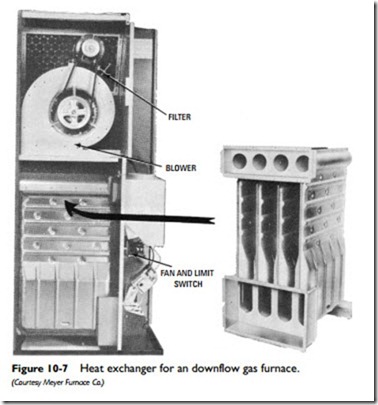Selecting a Furnace for an Older House
Sometimes an older house or building will have a furnace that needs replacing. If you are planning to install a newer model of the same kind of furnace, you should have no serious difficulties. However, be sure that the newer model develops a similar Btu rating at both register and bonnet. In a forced-warm-air heating system, the ducts are sized in accordance with the overall requirements of the system, and a furnace is selected with a capacity to meet these requirements.
Switching from coal to gas or oil also should not present any great difficulties. Conversion burners have been designed and manufactured for just this purpose; see Chapter 16, “Boiler and Furnace Conversions.”
Installing an electric-fired furnace in an older structure is not generally recommended unless the construction is particularly tight and well insulated.
Furnace Components and Controls
Most forced-warm-air furnaces have the following basic components and controls:
1. Heat exchanger
2. Blower
3. Air filter
4. Primary control
5. Fan and limit controls
6. Thermostat control
The heat exchanger (Figures 10-6 and 10-7) is a metal surface (0.05- to 0.06-in steel) located between the burning fuel and the circulating air in the furnace. The metal becomes hot and transfers its heat to the air above, which is then circulated through the ducts by the blower.
Most forced-warm-air furnaces are equipped with either a disposable or permanent (and washable) air filter to clean the circulating air. An air filter is not recommend for a gravity warm-air furnace, because it tends to restrict the air flow.
Most warm-air furnaces are thermostatically controlled. In addition, there will be a primary control as well as fan and limit controls. Among the functions of the primary control is the regulation or stop- page of the flow of fuel to the combustion chamber when the fire is out or the thermostat indicates that no further fuel is needed. The fan and limit controls are also actuated by the thermostat and are designed to start or stop the fan when the temperature in the furnace bonnet reaches predetermined and preset temperatures. In warm-air furnaces, it is suggested that the limit-control switch be placed in the warm-air plenum, with a recommended setting of 200°F for a forced- warm-air furnace and 300°F for a gravity warm-air furnace.
These and other controls are offered by furnace manufacturers in a variety of different combinations. Their primary function is to provide safe, smooth, and automatic operation of the warm-air fur- nace. More detailed descriptions of the controls used in furnaces and heating systems are found in Chapter 4, “Thermostats and Humidistats”; Chapter 5, “Gas and Oil Controls”; Chapter 6, “Other Automatic Controls”; and Chapter 9 of Volume 2, “Valves and Valve Installation.” (Other chapters also include sections on automatic controls. Check the Index).
Most warm-air furnaces (except hand-fired coal furnaces and electric-fired furnaces) are provided with devices that automatically prepare the fuel for combustion or to feed it directly to the fire. These devices (oil burners, gas burners, and automatic coal stokers) are described in the appropriate chapters. Electric-fired warm-air furnaces utilize electric resistance heaters.
Cooling coils, electronic air cleaners, and humidifiers are examples of optional equipment that can be added to most forced-warm- air furnaces to provide total environmental control. It is best to include this optional equipment when the furnace is installed rather than add it at a later date. By doing so, you avoid complications that might arise in the overall design of your heating system. For example, adding air conditioning capability is not simply a matter of installing cooling coils. Duct sizes must also be considered, and they are not necessarily the same as those used for heating. This optional equipment is considered in detail in Chapters 7 and 8 in Volume 3.

